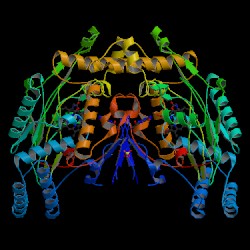This web page was produced as an assignment for an undergraduate course at Davidson College.
![]()
Upon infection with D. immitis, an innate immune response of the host is mounted against the pathogen. The initial response is one of inflammation, which is characterized by the accumulation of fluid, plasma proteins, and lymphocytes at the site of infection (Janeway et al., 2005).
Inducible NO synthase is present in dogs infected with D. immitis provides evidence for the type of defense mounted by the innate immune system (Simon et al., 2007). This toxin is produced by macrophages and is one of the major mechanisms by which a host responds to an intracellular pathogen infection (Janeway et al., 2005).
Evidence of the innate immune response is also seen through the presence of TNF-α.. This cytokine, produced by macrophages and T cells, has major functions in the innate immune response. TNF-α is essential to activating inflammatory responses as well as activating natural killer cells. These cells act to rid the host of the pathogen through antibody-dependent-cell-mediated-cytotoxicity (Simon et al., 2007).
Neutrophils, a cell of innate immunity, are often found in the kidneys and walls of the pulmonary arteries in dogs infected by D. immitis (Simon et al., 2007) . These cells specialize in phagocytoising extracellular pathogens (Janeway et al., 2005).
 |
|
| iNOS is produced by effector cells to defend the host against D. Immitis (12). Courtesy Christian Hesketh. http://www.ionchannels.org |
TNF-α is a cytokine produced by Tt cells and macrophages as part of the innate immune response (12). Courtesy Christian Hesketh. http://www.ionchannels.org |
Simon, F. and L.H. Kramer. 2007. Immunopathology of Dirofilaria immitis infection. Veterinary research communications 21:161-171.